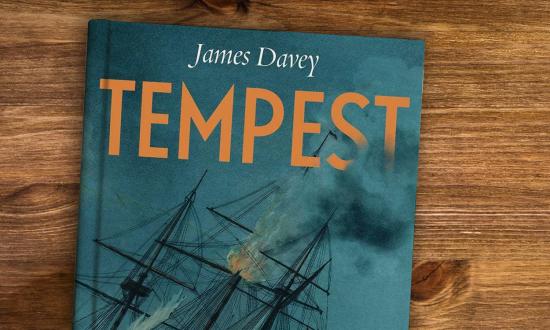Adventurers: The Improbable Rise of the East India Company, 1550–1650
David Howarth. New Haven, CT: Yale University Press, 2023. 459 pp. Maps. Table. Notes. Index. $35.
Reviewed by Captain Sam J. Tangredi, U.S. Navy (Retired)
Readers expecting a fast-paced, action-packed history by Royal Navy officer and prolific writer David Howarth (now
deceased) need to be advised that the author of Adventurers is not that David Howarth. Rather, he is professor emeritus at the University of Edinburgh, whose previous books deal primarily with English economic and social history. Instead of men (and a few women) braving the seas, the term “adventurers” in the title refers to those who “ventured” their capital to support the long-shot, highly leveraged, against-all-odds effort of the British to trade in the regions of maritime East Asia already dominated by the Spanish, Portuguese, and Dutch. This usage is accurate for the time; anyone who invested at least 200 pounds sterling in the fledgling East India Company “qualified as an Adventurer, and so by rights would be admitted to the General Court”—the equivalent of being allowed to vote at a shareholders’ meeting.
That is not to say that Howarth does not include exciting events on land and sea, as well as courageous and colorful characters whom he sympathetically portrays. The captains, crews, and merchants of East India Company braved deserts and oceans, survived shipwrecks (or not), negotiated with shrewd and sometimes semihostile rulers, built warehouses and forts, and both collaborated with and fought pitched battles against the merchants of other European nations—all
of whom wanted a monopoly in their trading regions. Losses in ships and personnel were tremendous to gain spices, silk, fine porcelain, and other luxury goods. But those who survived and returned made tremendous profits for the company, rarely less than 200 percent and often much more.
These colorful characters include the peoples with whom they traded. One remarkable example is the “Olde Queene” of Pattani, now a province of Thailand, who acted as a banker to the European merchant adventurers who found themselves cash strapped once they got to the East—with loans at high rates of interest. Acquiring specie from all the trading nations, she lent to the Dutch as well as British at a minimum of 10 percent per annum, with a 1 percent commission to her and her treasurer. Her negotiating technique was to get the East India Company traders drunk at a lavish feast the night before and then demanded “outrageous interest rates, set not according to the value of one
currency against another, but with an eye to how serious was the hangover of her supplicants.”
After beginning with the exploits of the forerunning Portuguese and details of how the East India Company was founded, much of the author’s focus is on the competition between the East India Company and the Dutch East India Company, since they fought on-again, off-again “wars” over who would have the local monopoly. Ships and “factories”—the warehouses and forts that defined commercial cities—changed hands frequently. In fact, the British seizure of island of Manhattan in North America from the Dutch was partly in retribution for Dutch seizures elsewhere.
Notably, Howarth is disparaging of religion as a motive for exploration (primarily by the Spanish and Portuguese) to a greater degree than other scholars, not so much because of related abuses of indigenous peoples, but because the efforts expended interfered with making money. Whether the absolute focus on profit accurately reflects the attitudes of the people described or is a bias of our own era is unclear.
Unfortunately, “unclear” could also describe much of Howarth’s writing. Attempting to convert a normally academic style to more popular prose, his results prove awkward. Sentences containing six or seven clauses are frequent—and confusing. His use of metaphor often becomes oppressive; some pages contain five or six unrelated metaphors, some of which are intended (but fail) to be droll humor. Worse is his tendency to overuse flashbacks and foreshadowing, making it hard to remember the sequence of events. Perhaps sensing this, he mercifully includes a chronological table at the end of the book. I had to refer to it often.
Yet, the book’s virtue is its well-documented research that exceeds competing efforts. Adventurers is a product of meticulous scholarly effort over decades; the author plied through—as he describes it—“8 miles” of papers of the East India Company, located at the British Library’s India Office Records. He does not claim it is a one-volume history of the company, but is content to describe only its first hundred years (to 1650)—a time when the sun still set on the (nascent) British Empire. It would be a hundred years later that Robert Clive would drive the French out of India, Stanford Raffles would found Singapore, and the commercial empire of the East India Company would evolve into a political possession of the Crown.
Adventurers covers a period of maritime and commercial history infrequently addressed. That is its ultimate value. Despite some difficult reading, all readers seriously interested in the commercial and economic beginnings of the
British Empire will do well to start with this book.
CAPT Tangredi holds the Leidos Chair of Future Warfare Studies at the U.S. Naval War College and has published six books. He is a frequent contributor to Proceedings and Naval History.
The Brown Water War at 50: A Retrospective on the Coastal and Riverine Conflict in Vietnam
Thomas J. Cutler and Edward J. Marolda, eds. Annapolis, MD: Naval Institute Press, 2023. 272 pp. Illus. Photos. Maps. Index. $34.95.
Reviewed by Lieutenant Commander Steven Wills, U.S. Navy (Retired)
The Brown Water War at 50, edited by noted naval historians Thomas Cutler and Edward Marolda, is a superb anthology of accounts from historians, analysts, and above all veterans of the naval war on the rivers and in the coastal areas of South Vietnam. While not a book about “great power competition,” the volume also offers a great deal of insight into the U.S. Navy’s current challenges, many of which have their roots in the era of the Vietnam War and its immediate aftermath. Each chapter has a story to tell of both past events and present dilemmas. Most important, the book shows that Vietnam was not just a land and air conflict, as many of the documentaries and other accounts suggest.
The book’s 12 accounts each tells a story about the maritime experience of the Vietnam War. Cutler provides an overview of the maritime component of the war, drawing on segments of his previous book on the subject, Brown Water, Black Berets (Naval Institute Press, 1988), but also wider questions such as why the United States chose to fight a land war in Asia, and why it went to Vietnam in the first place. The brown-water war was fought mostly by volunteers, serving for the miserly $75 extra a month in combat pay. Marolda’s chapter focuses on the strategic background and theater-level operations of the brown-water war. He notes that given the wider mission of deterring the Soviet Union, the Navy improvised and operated an effective brown-water force, often with ships and weapons from World War II, rather than the missile systems then joining the fleet.
Retired Navy captain and naval strategist Peter Swartz’s account invokes some of the spirit of movies such as Apocalypse Now, in terms of small boats and counterinsurgency. Oral historian and Vietnam veteran Paul Stillwell’s chapter reminds the reader of the importance of the vast logistics needed to conduct the Vietnam War, as seen from his ship, the tank landing ship USS Washoe County (LST-1165).
Historian Paul Weist’s chapter tells the story of the Mobile Riverine Force, a joint formation of an entire Army division (the 9th) and four squadrons of heavily armed Navy riverine assault craft. This force, reminiscent of the U.S. Army-Navy force on the Mississippi during the Civil War, was a successful joint operation long before the Goldwater-Nichols Act bureaucratized jointness. Naval aviation historian Hill Goodspeed’s account further explores joint operations in the air as it follows Army and Navy air ops in support of the maritime campaign.
Marine Corps veteran and historian Charles Melson’s chapter relates the close Navy and Marine Corps relationship in the Vietnam maritime campaign, a mission often overshadowed by the heroic defense of Khe Sahn and the retaking of Hue City. Close Navy–Marine Corps cooperation as seen in Vietnam is again underway as the Marines seek to return to a naval focus after decades of war in Southwest Asia. Historian George Veith well covers the “allies and partners” part of the war with the operations of Vietnamese forces alongside their U.S. counterparts. The Vietnamese Navy and Marine Corps’ operations are often forgotten in the wider Vietnam War narrative other than that they operated poorly, and Veith’s account should disabuse the reader of this simple understanding. Retired naval intelligence officer Richard Mobley’s chapter explores the dangers of underestimating an opponent, and especially their logistics train. Historian Xiaobing Li further details the amount of aid provided by China to North Vietnam. Navy medical historian Jan K. Herman explores the advances in military medicine during the conflict, and defense analyst and historian Norman Friedman covers the history of the beginnings of distributive, mass sensors in Operation Igloo/Duffle Bag.
These accounts of the Vietnam War also tell the reader something about today’s Navy’s challenges. There should be a large-scale strategy with offramps to the end game, as Marolda suggests, for present and potential future conflicts. The question of why the United States engages in war, as Cutler writes, should be in the forefront of decision-making before every time service members go “in harm’s way.” Inspirational leaders make the difference, even in unpopular conflicts, as Swartz’s account suggests of Admiral Elmo Zumwalt, whose presence looms large in many chapters of the volume. Weist’s, Goodspeed’s, and Melson’s chapters suggest that the services can and do come together well for joint operations, and that increasingly complex, joint leadership staffs and schemes detract from, rather than aid, mission accomplishment. Stillwell’s and Xi’s accounts tell the reader that wars are won with logistics and not by combat victory alone. The advance of medicine to return the injured safely from the battlefield and the need for uncrewed surveillance systems are also both part of current military improvement programs.
The Vietnam War’s end brought about a refocus on great power competition with the Soviet Union. Many of the
concepts developed in Vietnam and detailed in this book played roles in the 1970s and 1980s and ultimate Cold War victory. The Brown Water War at 50 is a superb overview of the wider maritime effort in Vietnam, as well as a herald of obstacles U.S. naval forces could see in the future.
Dr. Wills is the navalist at the Center for Maritime Strategy in Washington, DC, and has worked at the Center for Naval Analyses. Prior to completing his PhD, he was an active-duty surface warfare officer.







